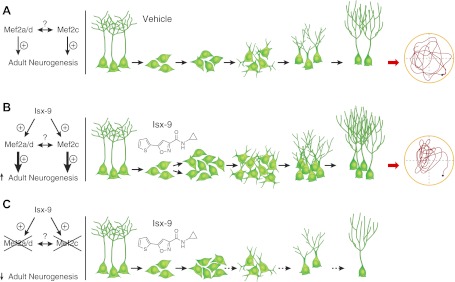Figure 4.
Model of how Isx-9 may positively influence adult hippocampal neurogenesis via Mef2-specific mechanisms to improve spatial memory. A) In WT Mef2 mice given Veh, both Mef2a/d and Mef2c support basal levels of adult neurogenesis. Their reciprocal relationship is yet to be identified. Adult neurogenesis is a process where NSCs (nestin+ Type-1 cells) with triangular cell body and tufted process produce transiently amplifying progenitors (nestin+ Type-2 and DCX+ Type-3 cells), which differentiate into immature DCX+ neurons (with short dendrites) that finally mature into DG GC (with long dendrites). Adult-generated hippocampal neurons are thought to contribute to hippocampal function, as represented by the activity trace of a mouse finding a hidden platform in the MWM (circular schematic at right). B) WT Mef2 mice given Isx-9 have increased proliferation of DCX+ SGZ progenitors and enhanced differentiation and dendritic arborization of DCX+ neurons, but no change in the number of Type-1 or Type-2 nestin+ cells. The improved adult hippocampal neurogenesis is linked to improved memory in the MWM, as represented by the more concentrated search pattern for a hidden platform (circular schematic at right). C) We propose that Isx-9 mediates enhanced neurogenesis via Mef2a/d and Mef2c. The absence of Mef2 appears to be antineurogenic, and Isx-9 exacerbates that effect. However, the precise relationship between Mef2 and basal neurogenesis and between the different Mef2 isoforms remains to be thoroughly tested.

